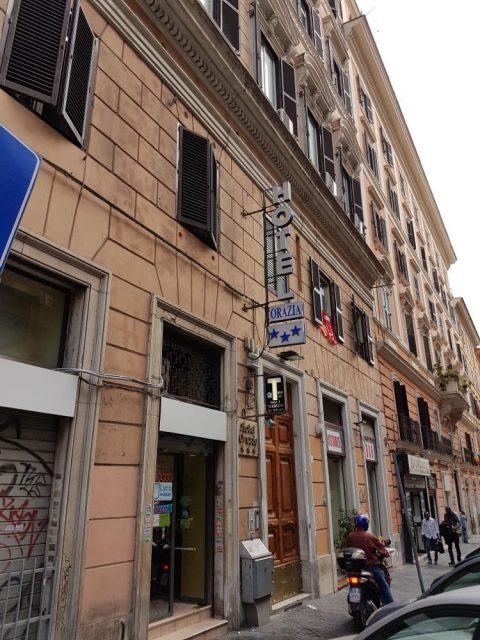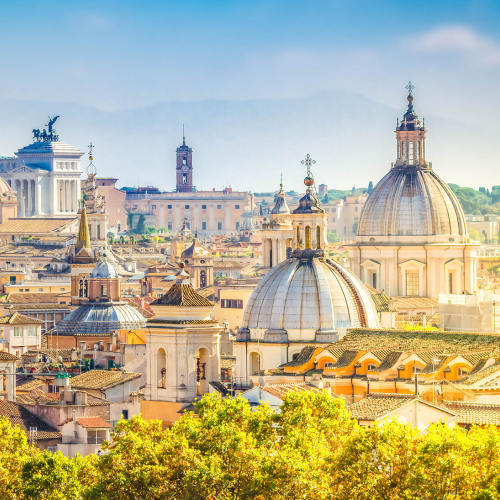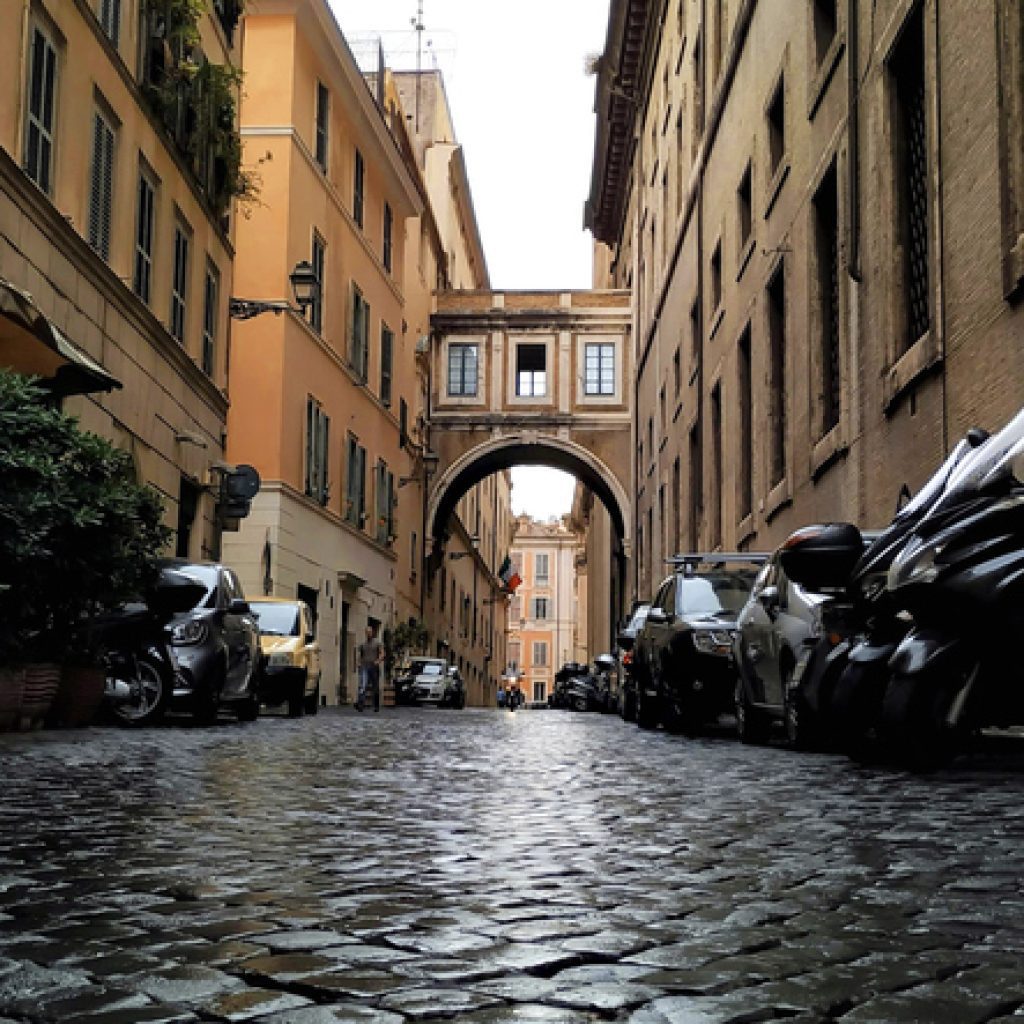Rome

Hotel Orazia in Rome
3 STAR RATING FOR HOTEL ORAZIA IN ROME ★★★★★ 3/5 Hotel Orazia in Rome, Sentral delight Hotel Orazia in Rome were visited in 2017. The

Hotel Villa San Lorenzo Maria, Rome
4 STAR RATING FOR HOTEL VILLA SAN LORENZO MARIA ★★★★★ 4/5 Stay at Villa San Lorenzo Maria, a peaceful hotel in the center of Rome.

Hotel Adèsso in Rome
5 STAR RATING FOR HOTEL ADÈSSO IN ROME ★★★★★ 5/5 Hotel Adèsso in Rome a new art hotel with focus on quality We stayed at

Rome the Eternal City
Rome


Venetian masks are typically worn during the Carnival of Venice, but have been used on many other occasions in the past, usually for hiding the wearer’s identity and social status. Masks back then were used during social gathering, criminal or personal use, and even for romantic encounters
St. Theodore was the first patron saint of Venice
No bikes, skateboards and roller skates are allowed in this city
Venezuela was named after the Italian name of the city of Venice – ‘Venezia.’ Venezuela means little
Venice in Spanish
The first casino in the world was opened here in 1638The first woman to receive an academic degree from a university was from Venice – Elena Lucrezia Corner Piscopia
Quarantine was first practiced in Venice too in the 13 th century during the plague.
Some famous people who were born here – Marco Polo, Antonio Vivaldi, Giacomo Casanova, Jacopo Comin or “Tintoretto” and Carlo Goldoni
Tradition has it that if a couple kiss as the gondola passes under a bridge, they will stay in love forever
- Earliest History of Rome
- Archaeological evidence shows that the first human settlers in Rome were dated from at least 5,000 years. However, researchers find it difficult to dig the Palaeolithic and Neolithic sites because of the thick layers of younger debris that covers the archaeological evidence that hides beneath it. Moreover, the legend about its first rulers, Romulus and Remus, overshadows the relevant evidence indicating the founding date of the city.
- The Legend of Romulus and Remus
- Rome is surrounded by rich legendary tales that revolve around how the city started and its first inhabitants.
- According to the ancient legend, Ascanio pioneered establishing the city of Alba Longa at the right side of the Tiber river banks. He was the son of two Trojan Aeneas named Venus and Anchises. The Aeneas peacefully dominated the settlement.
- When Nimitor became king, he was ousted out of power and dethroned by his own brother Amulius. In order to ensure that no one from Nimitor’s lineage will inherit the throne, Amulius killed his male heirs and forced his daughter, Rhea Silvia, to be a Vestal Virgin.
- As years went by, Rhea Silvia gave birth to a twin and named them Romulus and Remus. Mars, the God of War was believed to be the father of the twins. When Amulius found out about it, he incarcerated Rhea Silvia and ordered the death of the babies by drowning in the Tiber river. But the slave who was tasked to carry out the order felt pity for the babies, put them in a basket, pushed them to the river, and let them float along with the current.
- The twins safely arrived at the area of seven hills where they were found, suckled by a she-wolf named Lupa, and brought to her hideout in Palatine Hill. Later on, the twins were found by a shepherd and her wife, who took them in and raised them as shepherds. They were natural-born rulers and when they reached adulthood, theory fought, killed, and ousted Amulius from the throne. This re-instated Nimitor’s, throne and once again became king of Alba Longa.
- In 754 BC, the twins decided to establish their own city. They roamed around the seven Hills from Aventine, Celio, Capitol, Esquiline, Palatine, Quirinal, to Viminal to find the perfect site to establish the city. Romulus chose to build his city in Palatine Hill and put up a wall surrounding it. However, Remus wanted the founding city to be built in Aventine Hill. To help them decide, they consulted the augury where birds are used as tools to determine the preference of the Gods. Remus said that he have seen six birds while his brother have seen twelve birds thus God’s favored Romulus choice. However, Remus insisted that the birds appeared to him first. In frustration, he trespassed his brother’s fenced hill which angered Rumolus, ignited an argument between them resulting in Remus’ demise.
- Romulus named the city after himself and that’s what we now know as Rome. He welcomed everyone to his city as citizens regardless of social class including the slaves and freemen.
- To populate the city, Rome needs wives for its citizens. Romulus hosted a festival and invited the neighboring tribe and communities where he executed a mass abduction of many young women also known as the Rape of the Sabine Women. This led to a war between the Romans and the Sabines. At the end of the war, Romulus decided to rule the city with King Titus Tatius, the king of Sabine.
- He developed an organized government by creating a Roman Senate composed of 100 noblemen named “Patres” which acted as the king’s advisory committee. The descending lineage of the Patres was called Patricians. A three Centuria of Equities class or the second class of Rome’s property-based class system next to the senatorial class was created mainly composed of Ramnes or Romans, Tities which is named after the King of Sabine, and Luceres or the Etruscans. Later on, he divided the citizenry into 30 Curia or groupings named after the 30 brave Sabines women who mediated to end the war between Romulus and King Tatius and start a peace treaty. Rome practiced democracy and the Curia formed the voting group in the Comitia Curiata.
- The Ancient Monarchial Government in Rome
- Rome’s traditional founding date is 753-04-21 BC. Archaeological findings support the theory that Rome’s first political model was a monarchial form of government. The Roman Forum located between Piazza Venezia and the Colosseum in Regia served as the political, social, and religious center of the Romans, and was formerly used as a royal residence. During the excavations of the place, researchers found a “glass of bucchero” inscribed with the word “Rex” which means king and was believed to be from the 17th century. Within the Roman Forum, they unearthed the Lapis Niger which was an ancient shrine and they found the word “Regei” and below the black marble, the laws that governed the people during that era were inscribed in it.
- Back in the day, Rome used to be a kingdom, and the institutions in the Lazo region made it easier to establish the idea of the ancient Roman monarchy. The Rex Nemorensis or King of the Forest, an example of an institution, was a priest that served Goddess Diana and was in charge of securing and preserving the forest during the 6th century BC until the formation of the Roman Empire.
- The Romans carried out these institutions for centuries and made some changes in each function to adapt to the needs of each period. During the period of the Roman Republic, the Rex Sacrorum, or King of the Sacred functions as the king figure but its role is limited to religious functions.
- Romulus, the son of the God of war and the daughter of Numitor, is believed to be the first king, and the name Rome was derived from his name. He created the Roman Senate and formed a body of laws which he used in maintaining a peaceful reign in Rome.
- From then on, Rome had seven kings including Romulus & Titus Tatius, Numa Pompilius, Tullus Hostilius, Ancus Marcius. Tarquinius Priscus, Servius Tullius, and Tarquinius Superbus. Historians doubt the veracity of the existence of the first four kings due to the lack of clear evidence. However, they believe in the authenticity of the existence of the last three kings because substantial archaeological artifacts support the claims.
- The Period of the Roman Republic (509 BC- 27 BC)
- The Roman Republic replaced the Roman Kingdom after the last king, Lucius Tarquinius Superbus, was vanquished by the noblemen of Rome in 509 BC. Rome allied with other Latin cities to battle against the aggression of the Sabines which led to their triumph in the Battle of Lake Regillius in 493 BC. It regained its dominance over other Latin cities after its tragic loss when the monarchial government was overthrown.
- However, it was only in 393 that this dominance was established when they finally repressed the Volsci and Aequi tribes. In 394 BC, Rome subdued the Veii tribe which limited the Etruscan influence making Rome the strongest and superior city in Latium. At the end of the 6th century BC, a formal treaty of support with Carthage was signed to put accurate limitations and rules in the scope of influence of each city and regulate the commerce between the two parties. The temple of Jupiter Capitolinus was sanctified and a consul was organized right after the treaty was placed.
- The Fasti Consulares is a set of documents that contains the identity of the consuls and magistrates and a chronicle that explains the most important historical events that transpired in the period of the Roman Republic.
- The different hill tribes such as Volscians, the Aequi, and Etruscans were the menacing rivals of Rome during the early times. But the Gauls, a group of people that rules most of the parts of Northern Europe or what we know now as North and Central East Italy, were the most savage and relentless one.
- Another historical struggle that shook Roman history happened in 387 BC when the ancient Gallic tribe called Senones led by Brennus ravaged, burned, and defeated Rome in the Battle of the Allia in Etruria. According to contemporary records, the Battle of Allia was Senones’ way of executing Rome for breaking the agreement on diplomatic neutrality in Etruria. They walked 81 miles to Rome without disturbing the nearby cities and the areas they passes by. As soon as they destroyed the city, the Senones withdraw their forces and returned home. Soon after, Brennus’ leadership ended when the infamous dictator Furius Camillus defeated him at the city of Tusculum.
- Years later, Rome stood back again with newly rebuilt buildings, stronger offenses, and later conquered the Etruscans and northern areas belonging to the Gauls territory. It was in 345 BC that Rome started to widen their conquest by seizing other southern Latin territories where it faced one of its hardest enemies, the brave and sagacious Samnites. The Safineis outwitted the Romans in the Battle of Claudine Forks in 321 BC where they trapped the enemy in a valley. Despite having the upper hand, Rome remained victorious, gained dominance on half of the Italian territory, and had the Greek Poleis inhabit the Southern peninsula in the 3rd century BC.
- In this era, the doors of the temple of Janus were only closed twice due to the series of wars that transpired from the inception of the Republic government up to the Principate era. When its doors are open, it means that Rome is at war. The city also faced major social challenges including the Conflict of the Orders which was political strife between Plebeians or commoners and Patricians or aristocrats wherein the commoners sought equal political rights with the aristocrats. This conflict opened doors to the establishment of the Constitution of the Roman Republic. In 494 BC, the first Plebeian Secession occurred where all Plebeians left Rome while it was at war with two of its neighboring tribes. This resulted in the development of the office of Plebeian Tribune granting commoners their first-ever political power.
- Rome assumed a Republic type of government in 509 BC but it took several years, a couple of centuries even, before it became the mighty and great city that we know now. It started being a major Italian city during the 3rd century BC. The Punic Wars, a series of wars between the Roman Republic and Great Mediterranean Empire of Carthage, which transpired from 264 to 146 BC brought honor, success, and new citizens to Rome making it the capital of an overseas empire.
- The Expansion of Roman Populace
- Rome’s population significantly increased at the start of the 2nd century BC when Italian farmers migrated to the city after losing their lands to Latifundia. After Rome’s victory in the First Punic War, they brought Sicily and Sardinia as allies. Some parts of Spain followed after the Romans intervened in the matters and dealings of the Greeks. At that time, the Hellenistic kingdoms and Greek worlds were weakened due to the relentless wars. While Rome admires Greek civilization, the Greeks perceived Rome as a useful ally that will help them win wars. It took less than 50 years for the Roman legion to keep the whole of mainland Greece under its control. Among the victories of the Roman legion includes the obliteration of the Macedonian Phalanx in 197 and 168 BC. Lucius Mummius, a Roman consul, extinguished Corinth in 146 BC which marked the end of a free Greece. Later that year, Cornelius Scipio Aemilianus, eventually obliterated Carthage and transformed it into a Roman province.
- Rome continued to expand its conquest in Spain along with the Roman politician Tiberius Gracchus who was known for his agrarian reform law seizing lands from the Roman state and wealthy landowners and giving it to poorer citizens. This prompted the king of Pergamum to surrender his kingdom and award it to the Romans. By the end of the 2nd century, the Cimbri and Teutones migrated to Italy through the Rhone river which caused a threat to the Romans. It was also this time that the Roman general and statesman, Gaius Marius, reorganized and reinforced the Roman army. He is known for being a consul for 5 consecutive times and 7 times in total and won momentous battles in 102 and 101 BC.
- During the last century BC, Rome was subjected to various struggles, especially during the first thirty years. Internal problems, the Marsic War from 91 to 87 BC between the Roman Republic and its autonomous Italian allies, and the Servile War which was a series of three slave revolutions against Rome were some of the major challenges that the Republic faced. Due to these challenges and threats, the Romans developed and improved their policies. As Rome becomes extensively powerful, wealthy, and domineering, its allies felt betrayed because they’ve fought alongside Rome but were not considered Roman citizens and were given little rewards for their bravery and loyalty. Eventually, at the start of the 1st century AD, tier demands were granted and they became Roman citizens.
- As the Imperium Romanum grew in power, new problems and demands aroused in which the old Republic political system, annual magistrate election, and sharing of power, cannot be resolved. The problem with the ineffective political system became evidently clear during the dictatorship of Lucius Cornelius Sulla Felix, the unreasonable rule of power of Pompey Magnus, and the installation of the first triarchy type of political institution.
- The Dictatorship of Julius Caesar
- It was in January 49 BC that Julius Caesar led his legions to defeat his opponents, conquer Rome, and govern Rome under his dictatorship for four years until his untimely assassination in 44 BC. Gaius Julius Caesar was a popular personality in Roman history. He served as a general and a statesman before taking part in the first triumvirate. He led the Roman armies during the Gallic wars and eventually defeated his greatest political rival, Pompey. The Senate tried to re-establish the Roman Republic after his demise but its champions were overpowered by Marcus Antonius who was Caesar’s former lieutenant and Octavian who was Caesar’s nephew.
- From 44-31 BC, the two struggled to maintain their power. However, on September 31 BC, Octavian was hailed victorious in the Battle of Actium against Antony and Cleopatra and took the throne of being the sole ruler of Rome. The same date also ended the Roman Republic and introduced the start of the Principate government or the first period of the Roman Empire.
- The Rise of the Roman Empire (27BC-476 AD)
- An empire is defined as a political system wherein a single person, often referred to as emperor or empress, rules a group of people. In Roman history, it is believed that Augustus Caesar initially established the empire system when he proclaimed himself as the first Roman emperor in 31BC and ended when Constantinople was overthrown in his seat of power in 1453 CE. During this time, the authority of the Senate was limited and served as an organization that supports the emperor.
- The High Empire ( 31 BC-305 AD)
- When the Roman Republic ended, Rome was at the peak of its success dominating the whole Mediterranean. Being the largest city in the world, it was considered the capital of a powerful empire. Its population at that time ranges between 450,000 and its peak populace reached up to 3.5 million.
- Augustus made Rome a grandeur empire by continuing and finishing Caesar’s projects. He also materialized his plans including the Forum of Augustus which was one of Rome’s Imperial fora and Ara Pacis Agustae which was an altar dedicated to Pax who was the Roman goddess of peace. According to history, Augustus proudly articulated the words “Urbem latericium invenit, marmoream reliquit” which translates as “I found Rome a city of bricks and left it a city of marble”. He expressed his satisfaction with what the city has become since he step into the throne. The progress was evident and undeniable that his successors tried to emulate his works and legacy by adding their own projects.
- However, during the reign of the fifth Roman emperor and last on the line of the Julio-Claudian dynasty, the Great Fire erupted and left the city in rubbles. The fire was believed to had started in the Circus Maximus on the night of July 19, 64 AD. Due to the extent of damage, the fire served as a perfect excuse to make new developments.
- During this period, Rome was a subsidized city and the central government pays 15-20% of its grain supply. With commerce and other industries contributing little to the economy, the goods and produce from other parts of the empire were used to sustain the need of the whole population.
- The Roman population gradually declined since its peak in the 2nd century. Nearing the end of the century at the time of Marcus Aurelius’ leadership, the Antonine Plague also known as the Plague of Galen erupted killing nearly 2,000 people per day. The Plague started in 165 AD and lasted until 180 AD. The death of Marcus Aurelius in 180 AD ended the reign of the “Five Good Emperors” and Pax Romana.
- Commodus bequeathed his father’s throne and took full imperial authority. Despite serving as co-emperor alongside his father since 177 AD, the Western Roman Empire continued to decline in number and power. In year 273, the Aurelian Wall was completed but the population at that time was around 500,000 only including the Roman aristocrats who migrated into the city after the city of Pompei was destroyed by the eruption of Mount Vesuvius in 79 AD.
- The Third Century Crisis (235-284 AD)
- The Third Century Crisis also known as Imperial Crisis and Military Anarchy described the political struggles and social cataclysm that Rome went through during the third century putting the empire at the brink of collapse. It weakened the absolute power and grandeur that the capital once holds. The crisis lasted for fifty years.
- The empire was subjected to new menacing threats from Barbarian and Sasanians invasion during this period. The army assumed political power in 235 due to the threat and amplifying pressure from the raids. The emperors during the era of the third-century crisis were focused on fighting off the enemies and securing the borders.
- Aurelian, who was the Roman emperor during the Third Century Crisis from 270 to 275 AD, led and won several military victories and brought the empire together. He also built a massive 20 km. perimeter wall surrounding the capital and completed it in 273 AD.
- Massive expenses were the consequence of wars and maintaining tight military security which led the empire to acquire huge debts. This dragged down the economic capability of its population. Some lost their values, identity, and possessions while others doubted their religious principles. New doctrines from the East and the growing Christian minority also made a significant impact on the beliefs of the people at that time.
- Rome formally remained the capital of the empire. However, the succeeding emperors spent less time in it. A military revolt broke in 284 AD which saved the empire and appointed Diocletian as Emperor at the end of the third century until 305 AD. His political reforms dispossessed the administrative capital, Rome, with its traditional role. He installed a Tetrarchy type of government which divided the ruling power. He appointed general Maximian to govern the western areas while he control and manage the eastern regions of the empire. Later, the emperor appointed two Caesars to help him.
- In 305 AD, Diocletian renounced the Tetrarchic government system as it proved ineffective without proper leadership. Emperors of the Western Roman Empire ruled their provinces from Milan, Ravenna, or Gaul. And in 330, Constantine the Great built a second Roman Capital in Constantinople.
- The Low Empire (305 AD- 476 AD)
- The low empire was defined by the spread, persecution, and acceptance of Christianity in Rome. It also marked Roman history when the first Christian emperor took his seat of power and reigned the empire.
- Christianity was introduced to Rome in the 1st century AD. However, the imperial government viewed it as a Jewish sector instead of being a religion. Emperors made no formal laws against it and the persecutions at that time were only carried by local government officials. In a letter sent out by Pliny the Younger to Emperor Trajan, he described Christian persecution and executions. Trajan’s response included that he should not actively look for Christians or think of condemning them. He should only castigate the open Christians who resist recanting their statements.
- Suetonius, a Roman historian, claimed that Christians were punished for no reason during Nero’s reign. Furthermore, Tacitus mentioned that Nero was held responsible for the Great Fire of Rome in 64 AD but the emperor tried to avert the blame to Christians making them responsible for the fire. Nero’s reign suppressed the Jewish sector and ignited a war against the Jews which later on destabilized the empire, initiated a civil war, and resulted in Nero’s suicide.
- Diocletian’s reign subjected the Christians to extreme persecution from 303 to 311. But in February 313, the Edict of Milan which was an official agreement to tolerate and treat Christians amicably was placed as an official policy.
- Constantine I started his reign as a solo ruler in 324-337 AD and became the first Christian emperor. Theodosius who became emperor from 379 to 395 AD implemented Christianity as the official religion in 380 AD. He made several changes during his reigns such as implementing a ban on visiting pagans, putting out the eternal fire in the Temple of Vesta, disintegrating the Vestal Virgins, forbidding and punishing the practice of Augury and witchcraft. He also declines the requests of the Pagan Senators to reestablish the Altar of Victory.
- The conversion of the Empire’s official religion to Christianity made the Bishop of Rome the superior religious figure in the empire. Later on, the Bishop of Rome became the Pope. On February 27, 380 AD, the three reigning Roman emperors issued the Edict of Thessalonica and made it official.
- Despite having a minimal role in the empire, Rome remained historically prestigious and emperors materialized their construction plans in the capital. Constantine built the Arch of Constantine, gave the Lateran Place to the Pope as a donation, and constructed the first and the great Old St. Peter’s Basilica. Maxentius created buildings such as the basilica in the Forum Romanum and Diocletian made the greatest bath or the Roman public baths.
- Significant Events in the Low Empire Period
- During this period, the city of Byzantium was reconstructed and became the capital of the empire. And on November 8, 324 AD, its name was changed to Constantinople or the City of Constantine.
- Theodosius divided the empire into Western and Eastern Roman Empire where his son Arcadius ruled the West and Honorius reigned in the East. In 476 AD, the Western Roman Empire collapsed while the Byzantine Empire survived until its disintegration in 1453. We now call it the city of Istanbul.

